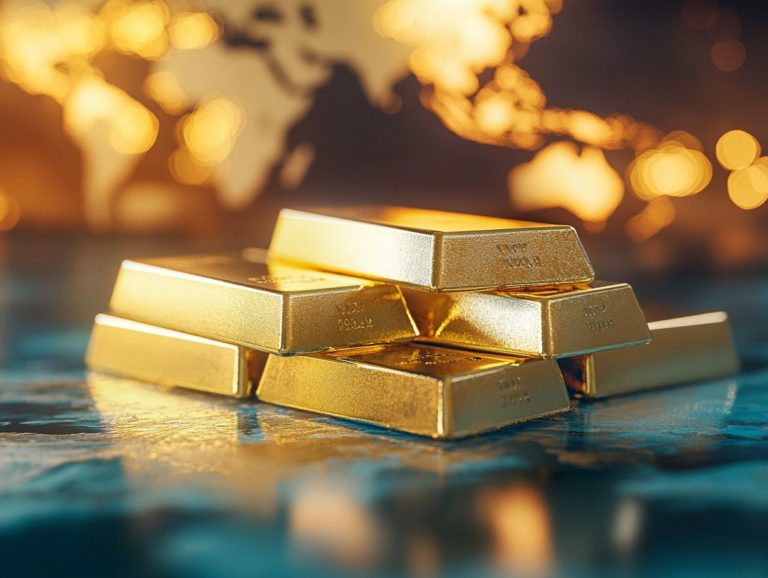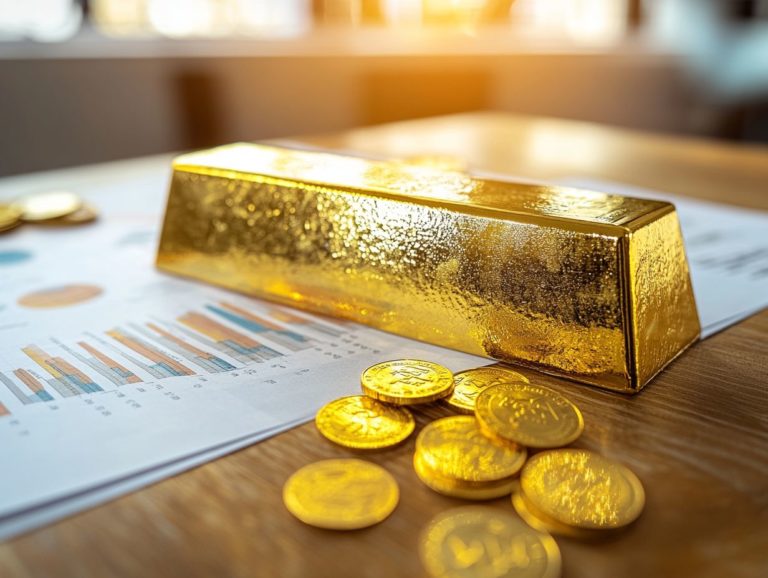5 Historical Events That Affected Gold Prices
Throughout history, gold has captivated our imagination, acting as both a symbol of wealth and a vital economic asset.
This article delves into five key events that have significantly swayed gold prices:
- The Gold Reserve Act of 1934
- The Gold Standard Act of 1900
- The California Gold Rush of 1849
- The Great Depression of 1929
- The Nixon Shock of 1971
You ll also explore the factors that influence gold’s value, various investment methods, and strategies to effectively navigate price fluctuations.
Get ready to discover the intricate relationship between history, economy, and gold as you embark on this enlightening journey.
Contents
- Key Takeaways:
- 1. The Gold Reserve Act of 1934
- 2. The Gold Standard Act of 1900
- 3. The California Gold Rush of 1849
- 4. The Great Depression of 1929
- 5. The Nixon Shock of 1971
- How Has the Value of Gold Changed Throughout History?
- Frequently Asked Questions
- What are the 5 historical events that affected gold prices?
- How did the California Gold Rush impact gold prices?
- What effect did the Great Depression have on gold prices?
- What was the Nixon Shock and how did it affect gold prices?
- How did the 2008 Financial Crisis impact gold prices?
- What effect did the COVID-19 pandemic have on gold prices?
Key Takeaways:
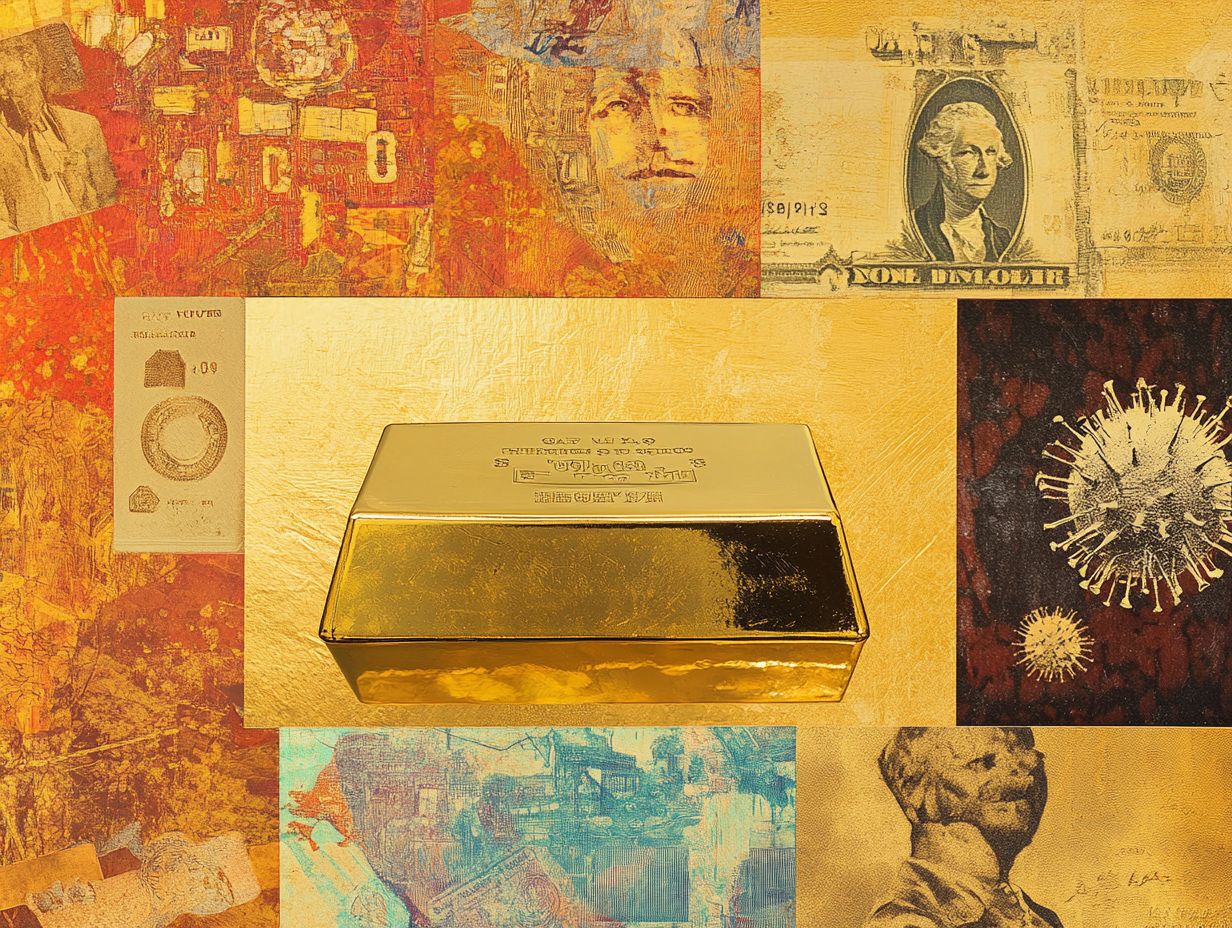
- The Gold Reserve Act of 1934 established the price of gold at $35 per ounce and ended the convertibility of paper currency into gold, leading to a decrease in gold prices.
- The Gold Standard Act of 1900 made gold the exclusive metal for redeeming paper currency, providing a stable foundation for monetary policy until its abandonment in 1933.
- The California Gold Rush of 1849 caused a surge in gold supply, leading to a decrease in prices globally and changing the U.S. economy forever.
These events have left a lasting impact on gold s role in the economy.
1. The Gold Reserve Act of 1934
The Gold Reserve Act of 1934 marked a turning point in history, enabling the U.S. government to seize control of gold reserves and fundamentally altering the role of gold in the economy.
In an era fraught with economic uncertainty and inflationary pressures, this legislation established gold as a vital asset class.
By transitioning to a more centralized financial system, the Federal Reserve began managing gold reserves to stabilize the dollar and combat inflation.
The implications of this act reached far beyond the United States; it reshaped the framework for central banks around the globe, prompting them to recognize gold as a safeguard for their currencies and a means to assert financial stability.
As confidence in paper currencies began to waver particularly during turbulent market conditions gold solidified its status as a universal safe haven asset, a perception that has endured through decades of economic upheaval.
This strategic pivot underscored the importance of gold in international trade and influenced monetary policies, ensuring that the allure of this precious metal would remain strong amid ever-changing financial landscapes.
2. The Gold Standard Act of 1900
The Gold Standard Act of 1900 firmly established the United States’ dedication to the gold standard, designating gold as the exclusive metal for redeeming paper currency. This pivotal move significantly shaped the nation’s economic history.
By adopting the gold standard, the country provided a stable foundation for monetary policy and effectively controlled inflation rates, fostering an environment ripe for economic growth and stability.
Anchoring the value of the U.S. dollar to a finite resource ensured that the issuance of currency was directly tied to the country s gold reserves.
However, the gold standard encountered significant challenges, especially during turbulent times like the Great Depression, when its limitations became glaringly evident.
The inability to expand the money supply without corresponding physical gold holdings contributed to severe deflationary trends, ultimately leading to a gradual move away from the gold standard as policymakers sought the flexibility needed to address financial crises.
3. The California Gold Rush of 1849
The California Gold Rush of 1849 was a key moment in U.S. history. Thousands traveled west, hoping to find gold.
This migration increased the demand for gold and led to many new mining companies. The fluctuations in gold supply and demand caused price swings that affected local businesses and investors.
As fortune seekers arrived, they helped build essential infrastructure like roads and towns. The Gold Rush was not just about mining; it significantly shaped America s economy and policies.
4. The Great Depression of 1929

The Great Depression of 1929 caused severe economic turmoil. Gold became a sought-after safe haven during this period.
As the value of currency dropped and banks collapsed, many turned to gold for security. This precious metal represented a reliable way to safeguard wealth during unstable times.
As trust in banks declined, demand for gold rose sharply. Investors sought refuge in gold, which drove prices higher amid widespread uncertainty.
5. The Nixon Shock of 1971
The Nixon Shock of 1971 was a major turning point, ending the direct conversion of the U.S. dollar to gold. This decision led to the rise of fiat currency amid growing inflation and geopolitical tensions.
Governments and financial institutions had to rethink their money management strategies. With central banks no longer tied to gold reserves, they could pursue flexible monetary policies.
This move made gold prices more unpredictable and pushed countries to diversify their reserves. Central banks began using tools like interest rate adjustments to stabilize their economies.
How Has the Value of Gold Changed Throughout History?
Gold’s value has fluctuated greatly over time due to various economic events and market conditions. It has served as both a precious metal and a safe haven for investors.
From the Great Depression to the 2008 financial crisis, these critical moments presented both challenges and opportunities for gold. When central banks lowered interest rates, many investors flocked to gold to protect against currency devaluation.
Geopolitical tensions and global demand continue to affect gold’s value, making it a key component of wealth preservation strategies.
What Factors Influence the Price of Gold?
Numerous factors influence the price of gold, and you’re right in thinking it s more than just a shiny commodity. Supply and demand dynamics, big economic changes, geopolitical tensions, and a pervasive sense of economic uncertainty all steer investors toward this precious metal.
The demand for gold in jewelry remains a key player, especially in emerging markets where cultural significance drives purchasing decisions. Central banks also make a notable impact by increasing their reserves, shifting the market’s supply and demand balance.
Fluctuations in mining production can also affect supply. Labor strikes or environmental regulations can tighten supply, often leading to price hikes. Market volatility can also play a crucial role; external economic events like inflation rates and currency fluctuations can alter investors perceptions. This can prompt them to turn to gold as a safe haven, intensifying demand pressures.
What Are the Different Ways to Invest in Gold?
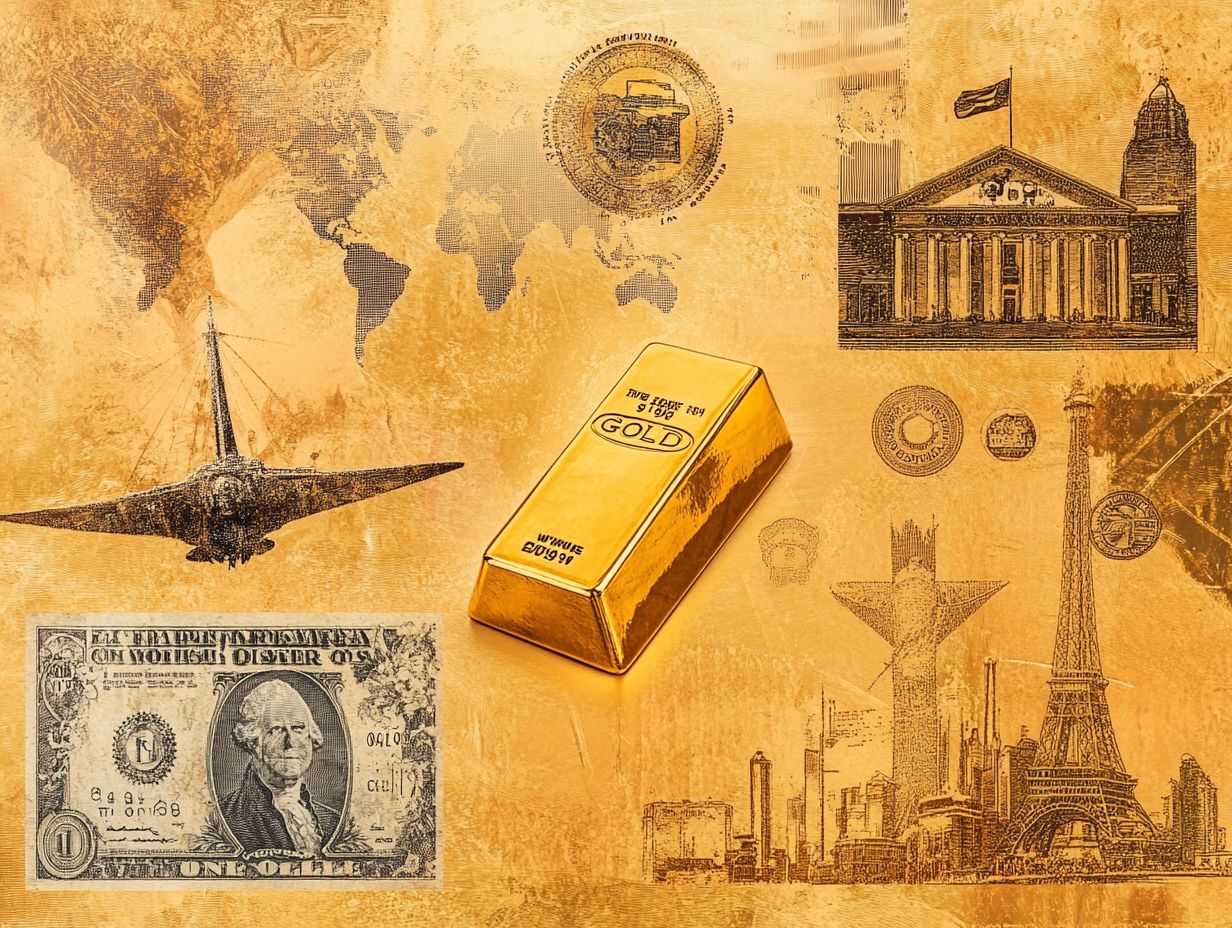
Investing in gold can take various forms. You can purchase physical gold bullion, coins, acquire gold certificates, or invest in Exchange-Traded Funds (ETFs). Each option presents unique advantages and considerations.
For instance, while physical gold offers the allure of tangible assets that many view as a safe haven during economic uncertainty, it also brings challenges. You must factor in storage costs, insurance, and potential liquidity issues when it s time to sell.
Gold ETFs provide a more liquid investment avenue, allowing you to buy and sell easily on stock exchanges without the hassle of storage. However, they may come with management fees and tax implications that could influence your overall returns.
Certificates present another convenient option. Yet, they might not deliver the same sense of security as physical assets, which some investors prefer. You have exciting choices to make when deciding which avenue suits your priorities and risk tolerance.
How Do Economic Events Impact the Price of Gold?
Economic events like financial crises, inflationary periods, and recessions profoundly affect gold prices. They often drive you to seek refuge in this precious metal during market chaos.
Take the Great Depression of the 1930s, for instance. It led to a drastic decline in economic stability, prompting individuals and institutions alike to rush toward gold as a safe haven.
Fast forward to the COVID-19 pandemic, and you see similar patterns. Widespread uncertainty and government stimulus measures ignited fears of inflation and enhanced gold’s allure as a hedge against instability.
Such events shape your perspective as an investor. You begin to view gold not just as a commodity, but as a trustworthy alternative to traditional currencies especially when confidence in financial systems starts to falter.
What Are the Long-Term Trends of Gold Prices?
Long-term trends in gold prices reveal cyclical patterns influenced by macroeconomic factors, inflation, and shifts in investor behavior. These trends offer valuable insights for crafting an investment strategy centered around this precious commodity.
By examining historical data over the decades, you ll notice significant price surges during economic uncertainty and inflationary pressures. Gold’s intrinsic value often serves as a safe haven, attracting investors who aim to hedge against potential financial crises.
As central banks adjust their policies in response to global events, the implications of these long-term cycles could reshape gold’s role within your diversified portfolio. Understanding these dynamics gives you the power to anticipate future trends and make informed decisions as economic conditions evolve.
Ready to explore gold investments? Dive into our resources today!
How Can Investors Protect Themselves from Fluctuations in Gold Prices?
You can protect your investments by assessing risks and spreading your money across different types of assets. This balanced approach helps maintain asset value.
Incorporating a mix of asset classes such as stocks, bonds, and real estate can cushion the impact of volatility in any single market. Keep a close watch on market trends and economic indicators to adjust your strategies as needed.
Reallocating assets in response to changing market conditions or modifying your investment goals can help align with your evolving risk tolerance.
Use this proactive strategy to confidently navigate the complexities of the gold market and strengthen your long-term financial stability.
Frequently Asked Questions
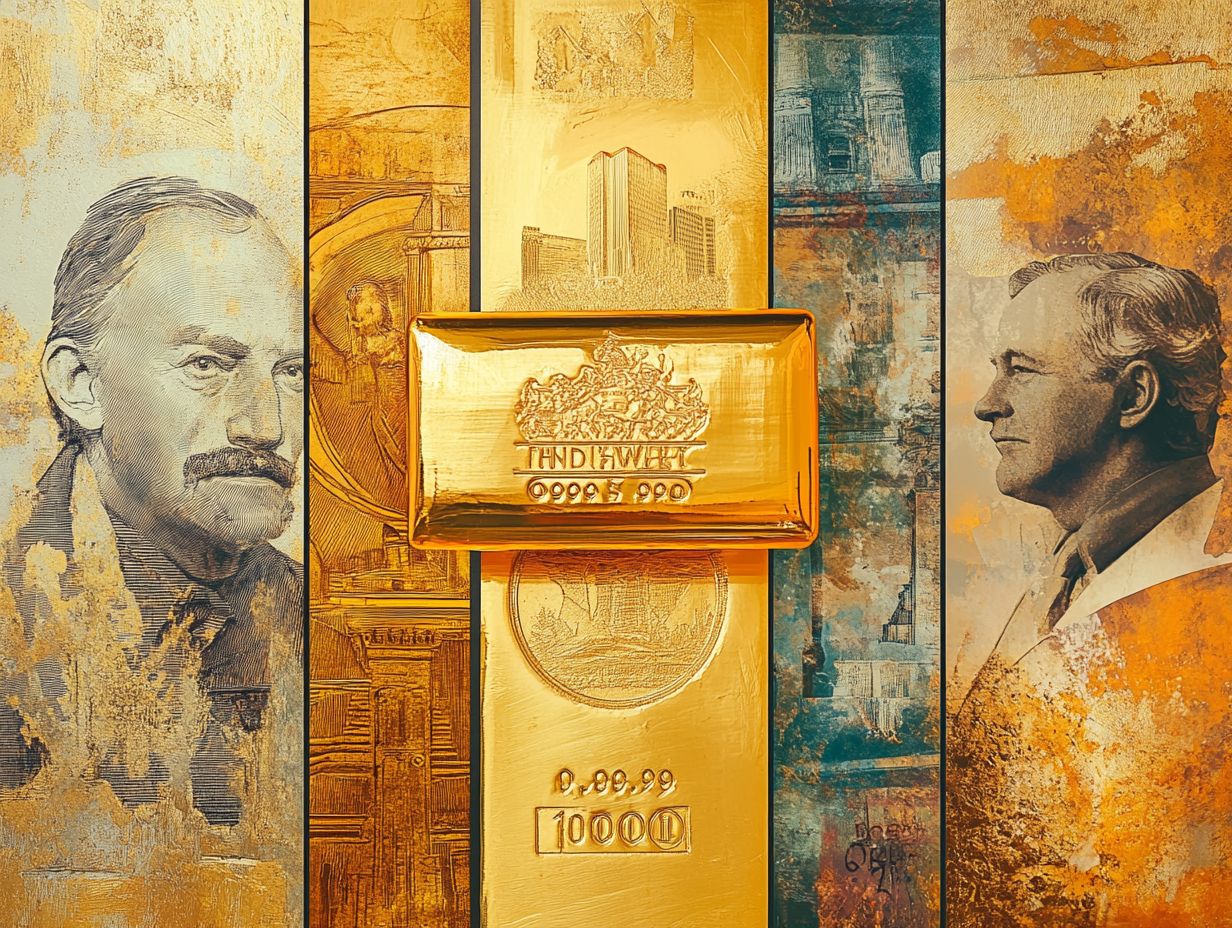
What are the 5 historical events that affected gold prices?
The five historical events that affected gold prices include the California Gold Rush, the Great Depression, the Nixon Shock, the 2008 Financial Crisis, and the COVID-19 pandemic.
How did the California Gold Rush impact gold prices?
The California Gold Rush, which began in 1848, significantly increased the supply of gold. This influx caused a decrease in gold prices due to higher availability.
What effect did the Great Depression have on gold prices?
The Great Depression, lasting from 1929 to 1939, surged demand for gold as a safe-haven asset. This increase in demand led to rising gold prices during that period.
What was the Nixon Shock and how did it affect gold prices?
The Nixon Shock was a series of economic policies implemented by President Nixon in 1971, which included ending the convertibility of the US dollar to gold. This change decreased the US dollar’s value and increased gold prices.
How did the 2008 Financial Crisis impact gold prices?
The 2008 Financial Crisis triggered a global economic downturn, leading to a decrease in currency value and rising inflation. Demand for gold surged as a hedge against inflation and a safe-haven asset, driving gold prices to record highs.
What effect did the COVID-19 pandemic have on gold prices?
The COVID-19 pandemic, starting in 2020, caused a global economic crisis and uncertainty. Investors turned to gold as a safe-haven asset, leading to a significant rise in demand and gold prices.











